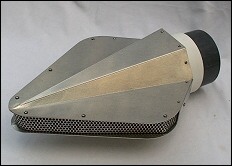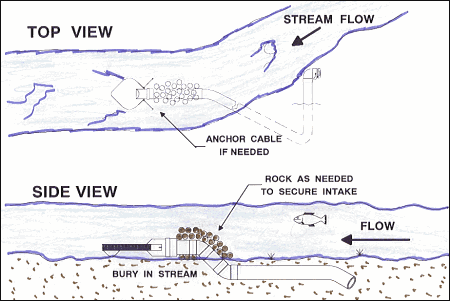Intake Strainers: Stream
Part # 12161-100 (6" only)
Design Usage:
 The
original "Trout Stream Strainer"
The
original "Trout Stream Strainer"
- Designed for horizontal installation in swift running or shallow streams. Strainer has a solid top and bottom with inlet around the 2" outer circumference. The strainer is shaped like an arrow head to deflect debris and prevent silt buildup which would obstruct intake of water. The unique shape of this strainer allows maximum flow with no internal restrictions.
- The Stream Strainer is designed to be placed with the bottom
plate 4"- 6" above the stream bed. It is preferable
for this location to be in a flat area of the stream (Not in a
depression). The sharp end of the strainer should be pointed downstream.
See diagram for installation techniques.
Pull Down & Flow Rates:
- 100% pull down to the top plate at lower flows. Flows of 1,250 - 1,500 gpm may require 6" - 8" of water above the top plate. Generally the swifter the stream flow the lower the water can be above the strainer plate and still maintain high flow rates.
Material:
- Sheet Aluminum formed for maximum flow and strength.
- Aluminum Wire mesh provides maximum intake.
- SST Screws and Nuts
- 6" Schedule 80 PVC Male coupling designed to glue to 6" Schedule 40 or Schedule 80 PVC pipe. Adapters to SDR 30 also available upon request.

Dimensions:
- Special design shaped like an arrow head.
- Width at widest point = 15 inches
- Length at longest point = 20inches
- Thickness at intake = 2 inches
- Thickness at highest point = 7.5 inches
Installation Suggestions:
- If needed consult your local Soil Conservation Department for
stream flow data and assistance with figuring drought conditions.
In many
locations the (RC&D) Resource Conservation and Development group
can also be called upon for assistance. - Before installation severe drought conditions at that specific site should be considered for both location in the stream bed and depth above the bottom. In cases of extreme drought and stream flow, it may be advantageous to build a shallow 1 ft. dam to create a deeper area in which to locate the strainer. In some situations local laws may need to be re-searched prior to any construction. It is recommended any retainer wall be placed downstream far enough to prevent silt build up around your strainer.
- If possible choose a stream bed location where the bottom is settled. (No Silt)
- If stream flows warrant, angle the pipe extending from the bank to the strainer, downstream at a 45 degree angle. The pipe should be buried below stream bed, if at all possible, to lessen damage to the installation from large debris (such as tree trunks and limbs) floating downstream during flooding conditions.
- The pipe should elbow up at a 45 degree angle immediately in front of the strainer. A second 45 degree elbow can then be used to make the installation parallel to the stream bed. If needed cement or large rocks can be used to further anchor the strainer and create a diversion point just in front of the strainer. Water is designed to flow over around and under the Stream Strainer.
- The completed installation should assure that the center line of the strainer is in line with the flow of the stream
- As a rule of thumb, the bottom plate of the strainer should be above the stream bed by 4 - 6 inches. If you have sufficient stream depth (say 2 ft.) you may wish to increase the clearance slightly.
- Upon completion reshape and properly re-seed the bank at the point of entrance to prevent soil erosion. If needed consult your local Soil Conservation Department for assistance in this project.
- The strainer assembly terminates in what is commonly referred to as a Dry Hydrant head or suction point. There are a variety of ways in which these can be installed. Most common is the above ground head, however a flush mount installation is available and works well in many situations. Specific instructions under "Dry Hydrant installations" can also be found on this web site for your design choice.
